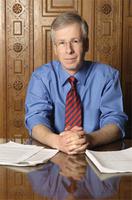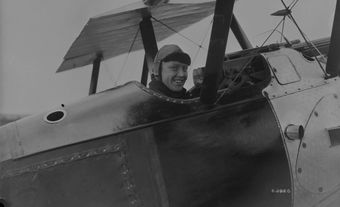
Stéphane Dion, academic, politician (born 28 September 1955 in Québec City, QC). A former university professor, Stéphane Dion has been involved in federal politics since 1996, when he joined the Liberal Cabinet under Prime Minister Jean Chrétien. Architect of the Clarity Act, he played a key role in developing the federal government’s position on Québec sovereignty. Dion became leader of the Liberal Party in 2006, but resigned this position following the election defeat of 2008. He sat as a regular Member of Parliament until 2015, when he became a Cabinet minister in the majority Liberal government under Justin Trudeau.
Education
Stéphane Dion is the son of the eminent political scientist Léon Dion, who was a professor at Université Laval and a constitutional adviser to a series of Québec premiers beginning in the 1960s. While a student at Laval, the younger Dion was a sovereigntist who campaigned in 1976 for the Parti Québécois. After receiving a bachelor’s degree and a master’s in political science from Laval, Dion moved to Paris, where he completed a doctorate in sociology at the prestigious Institut d'études politiques.
Professor of Political Science
In 1984, Dion accepted a position in the Department of Political Science at the Université de Montréal, specializing in Canadian politics and public administration. His views on the Québec question crystallized in 1991, when he was spending a sabbatical year at the Brookings Institution in Washington. While drafting a presentation on Québec nationalism for one of the think tank's seminars, Dion realized that he was a federalist.
During the 1995 Québec referendum campaign, Dion was a frequent television commentator, one of the few Québec intellectuals who defended the federalist position. His logical and precise attacks on the separatists caught the eye of Prime Minister Jean Chrétien, who asked the young professor to join his Cabinet.
Federal Cabinet Minister
From 1996 to 2003, Dion served as president of the Privy Council and minister of intergovernmental affairs, with responsibility for national unity. Though a political rookie, he carried much weight in Cabinet and was the key figure in shifting the federal government's position on Québec. Ottawa had previously avoided the hypothetical question of what would happen if Québeckers voted to separate. Dion, however, attacked the issue directly. He argued publicly that if Canada were divisible, so too was Québec, meaning that the province could not expect it keep all its territory if it left Canada. Although he recognized Québec's right to independence, Dion insisted that the province could not become sovereign without first negotiating terms of separation with Canada. Increasingly, Dion's arguments won him the enmity of the Québec political and media elite, with the Montréal daily La Presseregularly portraying him as a rat in editorial cartoons.
Dion convinced the Cabinet to ask the Supreme Court whether a province could unilaterally secede from Canada. In August 1998 the court ruled that a province could not, under international or domestic law, unilaterally declare sovereignty. At the same time, the federal government could not prevent Québec from leaving if an unmistakable majority of the province's residents indicated that they supported independence.
Against the conventional wisdom and the private views of many of his Cabinet colleagues, Dion responded to the ruling by drafting the Clarity Act, which became law in June 2000. The legislation affirmed that Canada would only negotiate a province's secession if a clear majority had voted for independence in a referendum based on a clear question. Critics insisted that the act would provoke a backlash in Québec, one that would help the sovereigntist side. These predictions proved baseless, as support for independence declined in subsequent months.
One of those who had been skeptical of Dion's approach was Paul Martin, who became prime minister in December 2003. Martin dropped Dion from Cabinet, offering his former colleague a diplomatic post if he would leave politics. Instead, Dion chose to remain in Parliament and to run again for the Liberals in his suburban Montréal riding of Saint-Laurent-Cartierville. Dion was marginalized in the party until the late days of the June 2004 election campaign, when he was brought back to prominence in an effort to shore up sagging Liberal support in Québec.
The Martin government won the election, but was reduced to a minority in the Commons. The prime minister invited Dion back into Cabinet, to serve as minister of the environment. In this role, Dion championed the Kyoto Protocol, an international agreement to reduce greenhouse gas emissions. In December 2005, he chaired the United Nations Climate Change Conference in Montréal, helping to extend the Kyoto Accord beyond 2012.
Liberal Party Leader
The Liberal defeat in the election of January 2006 ended Dion's tenure as environment minister and Martin's as Liberal leader. In April, Dion announced he would run for the party leadership, though few pundits gave him much of a chance. In a pack of eight, Dion was sixth in campaign donations and fourth in committed delegate support on the eve of the December convention. Still, polls showed him to be the overwhelming second choice of the delegates. On the fourth ballot, Dion was elected party leader.
Dion inherited a troubled party. The Liberals were disorganized and deep in debt. Internal dissent continued to linger after the long civil war between the supporters of former leaders Jean Chrétien and Paul Martin. Dion also had to cope with Conservative attacks. Throughout 2007 and 2008, the Conservatives spent millions of dollars on advertisements that portrayed Dion as an ineffective leader. Behind in the public opinion polls, short on funds and with a party organization that was unprepared for an election, Dion's Liberals backed away from opportunities to defeat the Conservative minority government.
Prime Minister Stephen Harper forced the issue in September 2008 by calling an election. The campaign did not go well for Dion. The centrepiece of his campaign was the "Green Shift," a promise to lower income taxes and to implement a carbon tax to reduce greenhouse gas emissions. The Conservatives depicted this as a simple tax increase and Dion as a weak leader. Despite his awkwardness in English, Dion performed well in the televised debates and in speeches late in the campaign, but this was not enough to salvage Liberal fortunes. On 14 October, the Liberals were reduced to 77 seats in the Commons from the 103 they had won in 2006. Six days later, Dion announced he would step down as party leader once a successor had been chosen.
When Parliament met in November, the opposition parties agreed to vote down the government and asked the governor general to appoint Dion as prime minister. To avoid defeat, Harper had Parliament prorogued until January.
The Liberals moved quickly to replace Dion, installing Michael Ignatieff as interim leader on 10 December 2008, and as leader at a party convention in April–May 2009. Dion remained in Parliament, but kept a low profile.
Government Critic
In the federal election of May 2011, the Liberal party was reduced to third place in the House of Commons with a mere 34 seats. One of those was held by Dion, who won his riding by a comfortable margin. Having led the party to its worst defeat in history, Ignatieff announced his resignation as party leader. Over the next four years, Dion was prominent on the Liberal front benches, speaking out on official languages, national unity, the environment and the handling of detainees by Canadian troops in Afghanistan.
Return to Cabinet
Dion won his seat again in the 2015 federal election and was appointed to the Cabinet of Prime Minister Justin Trudeau. He became minister of foreign affairs and chair of the Cabinet Committee on the Environment, Climate Change and Energy. He had emerged as a respected elder statesman within the Liberal party.

 Share on Facebook
Share on Facebook Share on X
Share on X Share by Email
Share by Email Share on Google Classroom
Share on Google Classroom


